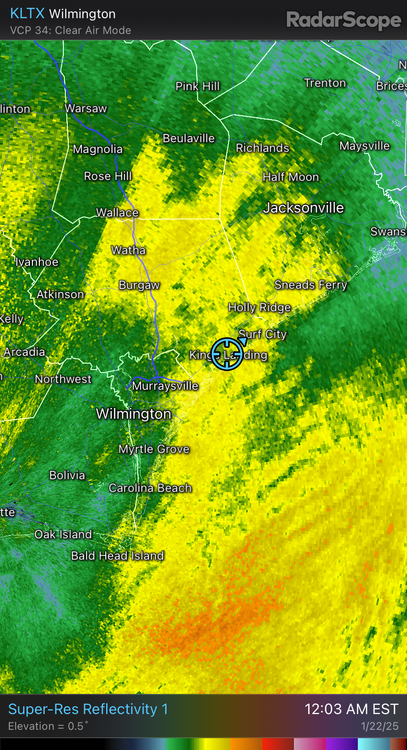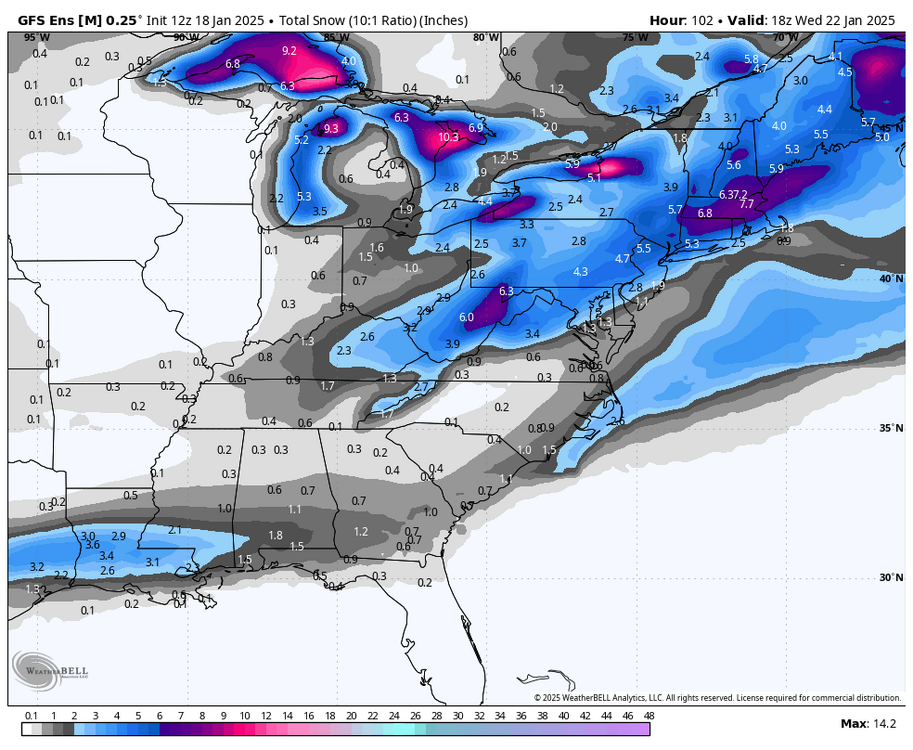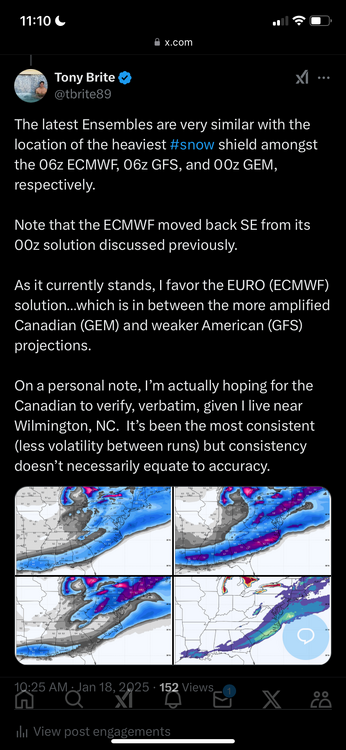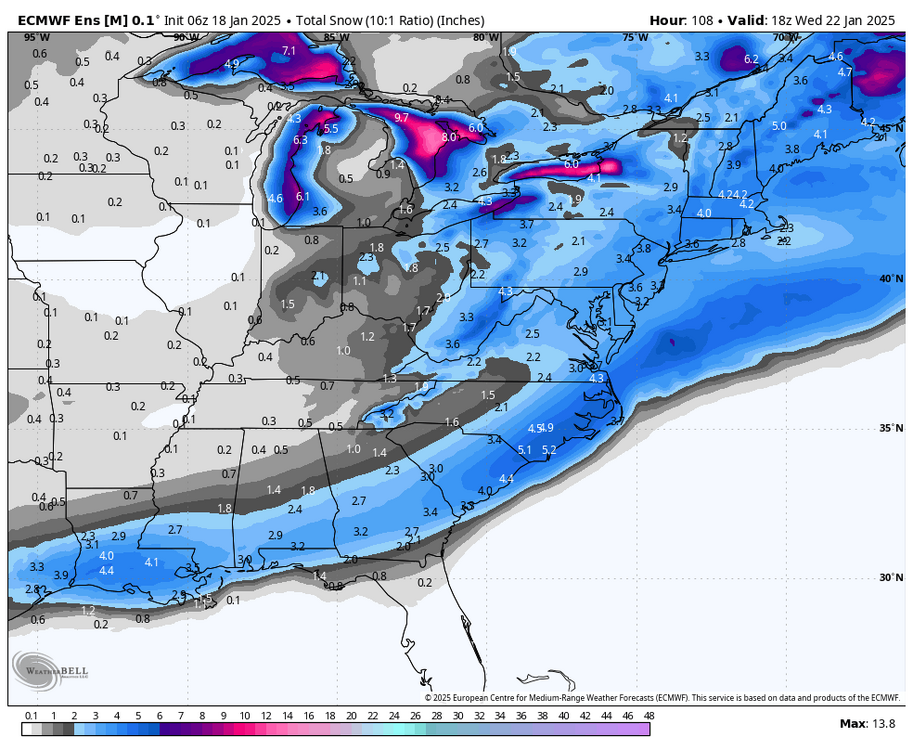-
Posts
1,191 -
Joined
-
Last visited
Content Type
Profiles
Blogs
Forums
American Weather
Media Demo
Store
Gallery
Everything posted by ncforecaster89
-

1/21-1/22 Winter Storm OBS Thread
ncforecaster89 replied to metalicwx367's topic in Southeastern States
That’s what’s occurring just N of Wilmington, in Hampstead. Sleet coming down extremely hard; wasting serious snow amounts. -

1/21-1/22 Winter Storm OBS Thread
ncforecaster89 replied to metalicwx367's topic in Southeastern States
It’ll take 6.5” at Wilmington to become a top 10 event. The record is 15.3” on 12/22-24/1989. -
To be fair, the advancement in computer processing power/modeling has dramatically improved our forecast accuracy, by an incalculable margin. The larger issues relate to both too much public accessibility to long range modeling (and the misuse, thereof) and poor messaging. In this social media age, too many content creators (or what I like to call socialmediarologists) are most interested in engagement farming and it hurts the integrity of the science and trust within the general public, at large. In addition, most don’t truly comprehend/appreciate the immense complexities involved with attempting to predict the weather, accurately, at even the short range. The truth of the matter is that it will always be an inexact science…yet it’s truly amazing how much progress has been made within just the past 30 years. I’ll conclude by stating that not a one of us meteorologists could consistently outperform the more reliable models…which is why we have them in the first place.
-
Bad sign to be honest and is likely a direct result of the aforementioned ingestion of actual in-situ data. It’s not too unusual to see such adjustments in the 60-84 hour range for that very reason. Hence, why I stated we’ve entered the critical 24 hour period for potential significant adjustments and usually a greater consensus amongst the deterministic guidance. Being that I live near Wilmington, NC, I’m going to take that “drink” @calculus1offered a few minutes ago!
-
Not necessary. But thanks anyway. I’ve been doing this for more than 30 years. As such, I know better than to put too much emphasis on any particular solution at these ranges. I was making an objective factual statement that we are just now entering the critical 24 hour period where the respective deterministic guidance typically builds a greater consensus because of the influx of actual in-situ data via sampling of the energy out W.
-
We’re still a relatively long ways out to be forecasting precise snowfall amounts. That said, I’d go with 2-4” for Wilmington, NC at this particular time. Should begin to see an ever-growing model consensus during the next 24 hours as the energy gets better sampled by the sondes.
-
Looking at the NAM beyond 48 hours is fools gold. The same applies to the Kuchera snow maps. If you want best accuracy, use 10:1 around here.
-
Suppression will cause depression
-
-
There is a pretty good consensus, currently, with regard to forecast track progression of the low and corresponding area of heaviest snow shield…as can be seen below. Still ample time to change, obviously.
-
-
I saw 8” on the Outer Banks in a middle January winter storm in 2018. Also, it was accompanied by thundersnow and 30 mph wind gusts at Kitty Hawk. Nothing like that since on the Outer Banks.
-
I respectfully disagree, the same synoptic pattern can still produce a 1989 redux. It’s a rare event for a reason, but it’s happened before and you can be certain it will happen again. Could be next week or 50 years from now, but the climate hasn’t changed that remarkably nor will it.
-
Quick off-topic question: Is WeatherBell that much better than Weather Models? I just purchased access to the latter this evening based on a few others preference for it. I really like the looks of these WxBell graphics you’re posting.
-
Me, too! But, I’m not looking at any deterministic runs until we’re inside 186 hours and even then, we need to be within 96 hours to really trust the signal. Still a long ways to go. That said, it’s better to see something at 200 hours than nothing at all. Just trying to keep things in their proper perspective.
-
Hi Ray! Nice to see you’re still doing it. I’ll add that If the pattern relaxation is delayed, then I also would adjust that period, accordingly.
-
As I’ve mentioned repeatedly on my Twitter account (since late December), I’ve always favored the forthcoming period of 1/19 to 2/3 for the greatest potential (enhanced probability) of getting a major east coast storm. This long range expectation has been, and continues to be, based on the premise that the majority of MECS’ have occurred during a period when a highly favorable background state begins to see a pattern relaxation. Does that mean there will definitely be a MECS at that time? Of course not. However, I do believe it provides an increased probability of its occurrence. For definitive purposes, I should note that I’m specifically taking about the prospects for a MECS somewhere between NC and SNE or actually encompassing both the Mid-Atlantic and NE regions. It'd be foolish to be more precise than that beyond a 7 day time frame, so I’ll just leave it at that that until we get closer in time.
-
Most certainly suspect they are thinking rain in the east. Of course, 8-15 days out is a virtual eternity for such prognostications…especially for specifics.
-

New England Winter 2024-25 Bantering, Whining, and Sobbing Thread
ncforecaster89 replied to klw's topic in New England
The most difficult aspect of such a project I’m encountering, or struggling with, relates to how best to compensate for the large disparities in snowfall totals between coastal cities and those more into the interior localities. This is especially true as most within the general public are naturally most concerned with what occurs in their own back yard, quite literally. What one might consider a “major” event at the coast could be quite different to another further inland…which is why I’m looking to devise a scale more refined than say, NESIS. -

New England Winter 2024-25 Bantering, Whining, and Sobbing Thread
ncforecaster89 replied to klw's topic in New England
I guess I should clarify that I’m attempting to devise a scale (1-5) that I would personally use/reference to highlight my own forecasting expectations (from a historical perspective) for a given prospective winter storm. In other words, if I’m forecasting the prospect of a “major” winter storm for the East Coast, I want to be assured that it justifiably fits within a specific criterion, e.g., a category 3 might correspond to a projected snowfall of 18-24”. Unlike with tropical systems, I don’t have multiple decades of experience either forecasting or researching snowfall totals in the Mid-Atlantic and Northeast U.S. As such, I have been spending much of my off-season free-time researching the snowfall climatology for the aforementioned regions. It’s a highly time-consuming and exhaustive process, but I’m most concerned with accuracy above all else in these type of endeavors. All that said, my initial post herein was meant to solicit feedback and opinions from those who are far more experienced and knowledgeable by virtue of actually living in the regions whereby I’m working to devise the aforesaid scale. -
Hi Everyone! Hope you all had a wonderful Holiday period and a good start to the new year. Hoping that the late January period might produce a significant winter storm. That aside, I wanted to ask about your own thoughts on how you might classify each respective winter storm event based on snowfall totals over a widespread geographical area (minimum of 4-6”)? Here’s my own best submission. Winter Storm Event Classification: Cat 1…….4-8”……….Impactful Cat 2…….6-12”……..Moderate Cat 3……12-18”……..Major Cat 4……18-24”…….Extreme Cat 5……24+”……….Historic Thoughts?
-

New England Winter 2024-25 Bantering, Whining, and Sobbing Thread
ncforecaster89 replied to klw's topic in New England
I’m trying to devise a general East Coast snowstorm scale (1-5) that best fits the associated descriptors corresponding to widespread equivalent snowfall. The fact that SNE has a much greater propensity for major events as compared to the mid-Atlantic region makes it difficult. Might be best to separate them, regionally. -

New England Winter 2024-25 Bantering, Whining, and Sobbing Thread
ncforecaster89 replied to klw's topic in New England
Guessing I could use “Extreme” as a descriptor for Cat 4 and reserve “Historic” for the Cat 5 designation. -

New England Winter 2024-25 Bantering, Whining, and Sobbing Thread
ncforecaster89 replied to klw's topic in New England
Hi Everyone! Hope you all had a wonderful Holiday period and a good start to the new year. Hope the late January period produces an opportunity to blizzard chase in your neck of the woods. Been almost three years at this point. That aside, I wanted to ask about your own thoughts on how you might classify each respective winter storm event based on snowfall totals over a widespread geographical area (minimum of 4-6”)? Winter Storm Event Classification: Cat 1…….4-8”……….Impactful Cat 2…….6-12”……..Moderate Cat 3……12-18”……..Major Cat 4……18-24”…….Historic Cat 5……24+”……….Generational









